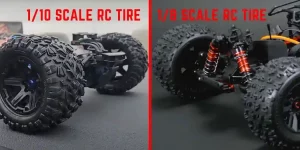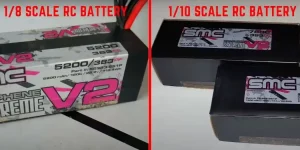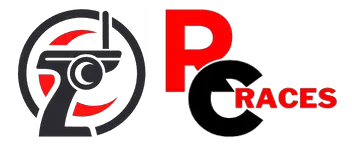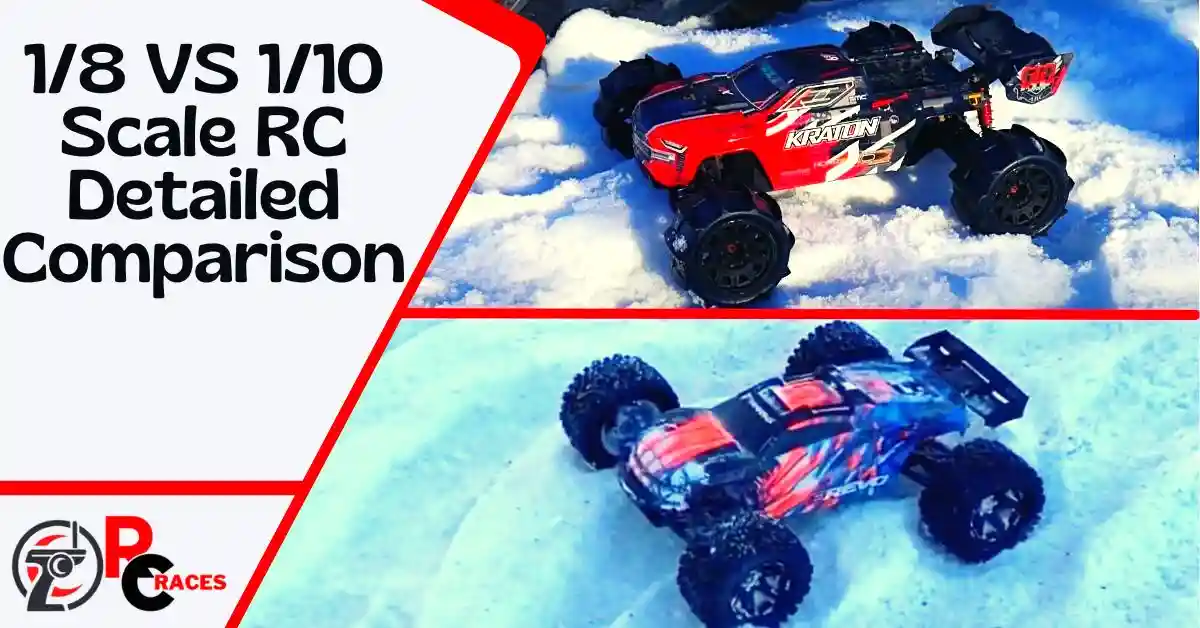Remote Control racing is fun. You might be wondering which RC vehicle to buy for ultimate amusement. The ⅛ or the 1/10 one.
Here we are comparing ⅛ vs 1/10 scale RC.
The ⅛ scale RC runs on any terrain with more speed than 1/10 scale RC. You’ll have better control over the ⅛ scale due to its heavier weight and bigger alloyed frame. The ⅛ is a better choice if you are a pro-level RC lover with better controlling skills. Mind you, the heavier the better!
There is more to explore about the two types of vehicles. So, let me help you out with more information. This would guide your buying decision since we will be going more in-depth into the comparison.
⅛ vs 1/10 scale RC – Basic Comparison
| Features | 1/8 Scale | 1/10 Scale |
| Fastest Speed | 110 Mph | 70 mph |
| Overall Size | 24 inches | 17.5 Inches |
| Materials used | Alloy Frame and Lexan Plastic | Aluminum and Metal |
| Tire Size | 17mm | 12mm |
| Weight | 2.45 – 4.54 kg | 1.45 – 3.1 kg |
| Control | More Stable | Less Stable |
| Battery | More Longevity | Heats up easily |
1/8 vs 1/10 scale RC – Detailed Comparison
Factors such as the speed, overall size, materials, and tire size are considered to compare the two. We will put in more effort to find out which one performs better.
Speed
Comparing 1/8 vs 1/10 scale RC top speed, the “1/8” scale is speedier due to its features, it runs faster. The scale speed of 110 mph for “1/8″ simply shows better performance. It speeds 40 mph faster than 1/10 which is running 70 mph.
If you don’t want to fall behind in the acceleration department, the 1/10 will make you happier with better acceleration. But here is a thing! When you look into the “top speed” portion, the ⅛ performs better in terms of top speed.
The average top speed of an RC car is usually measured at around 35mph.
However, the top speed variable also depends on the brand of RC cars. Some ambitious brands are promoting higher speed. But, smaller RC cars can go really fast!
For example, some brands like JLB or Traxxas are offering from 50mph to 100mph.
The recorded top speed of these two are 110mph and 70mph “scale speed” respectively.
Overall Size
1/8 scale RC car is bigger than 1/10. For ⅛, the size is 24 inches long. On the other hand, the 1/10 RC is usually 17.5 inches long. Some brands can go up to 22 inches.
The 24-inch long size helps the ⅛ to adapt to any terrains easily. It can run on any terrain such as muddy, grassland, or sandy. So, you can say that the size determines the performance.
Materials used
As the chart above suggests, 1/8 performs relatively better than 1/10 because of the materials used. 1/10, with its aluminum features, depreciates faster.
The difference in the 1/8 vs 1/10 scale RC materials used suggests something about performance.
In this regard, the alloyed frame features of ⅛ perform better on any road. Depending on the factors such as depreciation, you have value for money.
This is important to many buyers.
Weight
The weight poses an important role in the durability context. ⅛ is usually 2.45 to 4.54 kg. On the other hand, the weight of 1/10 is 1.45 to 3.1 kg. It is said that the one which is cost-friendly is not so durable.
Durability, however, depends on more factors rather than just weight. The Alloy Frame feature of ⅛ is more durable and also weighs more.
Bear in mind that the overall product dimensions replicate the weight of the buggies. Since there are many brands available, the size and weight also may vary.
Tire Size
While measuring 1/8 vs 1/10 scale RC tires, the usage can be a vital factor. ⅛ Scale has bigger tires than the 1/10 scale. Bigger tires are usually beneficial as supported by the bigger wheel size.

The 17mm tires of ⅛ scale are usually functioning better. Comparatively, the 12mm tires on a 1/10 scale are losing to the 17mm tires. Some brands such as Traxxas have different tire sizes.
Bigger tires provide the advantage of smooth run over all types of roads. This is where the performance of the buggies resides. You can have a fun time controlling without any hassles.
Control
Due to its bigger size, the ⅛ RC adjusts itself more comfortably. It is very stable and does not flip or turn. Basically, the user is ensured with the ability to control 100%.
You may find that the 1/10 is flipping and turning more. This may make the performance undesirable with more hassles while controlling. You can see that the tires are absorbing dirt easily.
This accounts for spending extra time cleaning the RCs. You simply have to put on more effort into maintenance when it comes to 1/10. In worst-case scenarios, The RC cars would stop moving.
The remote control can lose its touch if you have to put extra effort into adjustments. At the end of the day, you want to have full control over your device. In this regard, ⅛ performs better.
Battery
The main aim here is to recognize how the bouncy roads are impacting the materials. There are batteries that do not last long when the car is running on bumpy terrains.
The overall performance is impacted if the batteries go dull easily. So you want to be buying a battery that can absorb the pressure.

In extreme cases, any normal battery can heat up easily. Sometimes the batteries can burst due to overheating and cause damage to the RCs as well. There are some good options for you as we recommend C2 and C4 batteries.
LiPo batteries show some good quality when it comes to the ability to resist pressure. Both ⅛ and 1/10 perform well with LiPo batteries. So, you have the good option of trying them.
As we differentiated the two scaled RC cars, we have a little product suggestion table for you.
| Model | Features | Link |
| ARRMA ⅛ Typhone 4×4 | A high-performing RC car with a favorable top speed. | Check |
| WL Toys 1/12 RC Car | Recorded average speed of 32mph suits lonely riders. | Check |
| ARRMA 1/10 Typhon 4×4 | Built with advanced technology that speeds well. | Check |
| Traxxas 93054-4-RED Chevrolet Corvette Stingray – 1/10 Scale | Can mount at speed of 30mph. | Check |
| ARRMA RC Car ⅛ Vendetta 4×4 | Built with a powerful brushless motor. | Check |
FAQs
What are the alternatives to ⅛ and 1/10 RC scale buggies and truggies?
There are 1/16 and 1/18. Each has its own features in terms of performance and durability. These two are manufactured under different brands and constantly facing competition. They are mostly built with Alloy Frame materials.
How much should I spend on RC buggies?
Depends on your budget. As outlined in several paragraphs, you must take the most cost-effective. With proper comparison, using detailed information, you must understand how much to spend.
Why does 1/10 don’t perform well on tough terrains?
Because the 1/10 is manufactured with materials that are lightweight. With this outlook, the 1/10 usually struggles on terrains that are sandy or bumpy. If they are run on tough terrains, the materials may get jammed easily.
Conclusion
Looking into 1/8 vs 1/10 scale RC, we have uncovered much information.
This can support your buying decision. However, do not get confused since your budget depends on a variety of factors.
Hopefully, you have acquired the necessary idea of choosing the right one for you.
Good luck!


